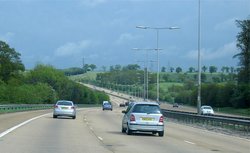M25 motorway
|
|
The M25 motorway is one of the UK's motorways. It is an orbital motorway which encircles London, and is approximately 117 miles (188 km) in circumference. It is the world's biggest ring road.
The motorway is mostly three-laned although there are a few short stretches which are two-laned and perhaps one sixth which is four-laned, around the southwestern corner. The Highways Agency plans to widen almost all of the motorway to four lanes in each direction, five lanes between junctions 12 and 14, and six lanes between junctions 14 and 15.
It is thought to be Europe's busiest motorway: an estimated 200,000 vehicles a day make use of it, up from 100,000 a day in 1987.
The M25 is not a continuous loop. To the east of London, the toll crossing of the Thames between Thurrock and Dartford is renumbered the A282. The Dartford Crossing, which consists of two tunnels and a bridge, is named Canterbury Way. Designating this stretch as a motorway would mean that traffic not permitted onto the motorway cannot cross the Thames at the only crossing point east of Woolwich. While this is more a structural than a logical issue, at junction 5 near Sevenoaks, continuing around the M25 requires the driver to follow the slip roads, as the main routes continue as either the M26 to the east (on to the M20) or the A21 towards the south coast.
The idea of an orbital road around London was first proposed early in the 20th century, through the Lutyens and Bressey plans of 1937 to the Abercrombie Plan of 1945 which proposed a series of five individual roads around the capital. Over time successive governments reduced this grandiose scheme to the Greater London Development Plan - a combination of two rings into one, the M25, and a smaller inner ring, initially hoped to become the M15, but currently still the A406.
The entire orbital was constructed in a number of stages from around 1975 up until 1985. The sections were not constructed contiguously but in small sections, such as Dartford to Swanley (Junction 1 to Junction 3) or Potters Bar to Waltham Cross (J24 to J25), and later joined. Each section was presented to planning authorities in its own right and was individually justified; there were almost forty public inquiries relating to sections of the route. Maps at this time depicting the short sections named the route as the M16 but this changed prior to completion.
The M25 was officially opened in October, 1986 with a ceremony by Margaret Thatcher opening the section between Junctions 22 and 23 (London Colney and South Mimms).
The initial tenders for the construction of the M25 totalled £631.9 million. This does not include compulsory purchase of land and subsequent upgrades and repairs.
More recently, the perenially congested south-western stretch of the M25 (near Woking) was fitted with an experimental automated traffic control system called MIDAS (Motorway Incident Detection and Automatic Signalling). This consists of a distributed network of traffic and weather sensors, speed cameras and variable speed signs which control traffic speeds with little human supervision. The system successfully reduced congestion and it is hoped that MIDAS will be fitted to the rest of the M25 in due course.
The M25 is known for its frequent jams. These have been the subject of so much comment from such an early stage that even at the official opening ceremony Margaret Thatcher complained about "those who carp and criticise". The jams have inspired jokes ("the world's biggest car park"), songs (Chris Rea's "The Road to Hell") and the following tongue-in-cheek theory:
- "Many phenomena - wars, plagues, sudden audits - have been advanced as evidence for the hidden hand of Satan in the affairs of Man, but whenever students of demonology get together the M25 London orbital motorway is generally agreed to be among the top contenders for exhibit A." -- from Good Omens, by Terry Pratchett and Neil Gaiman.
The M25's name inspired the name of the electronica duo, Orbital although a pre-cursor of the M25 was the North Orbital road.
See Also
- Paris Périphérique
References
- Iain Sinclair, London Orbital: A Walk Around the M25, 2002, Granta Books, ISBN 1862075476
External Link
- The Motorway Archive's M25 page (http://www.iht.org/motorway/londonm25.htm)
- CBRD Motorway Database - M25 (http://www.cbrd.co.uk/motorway/25.shtml)


